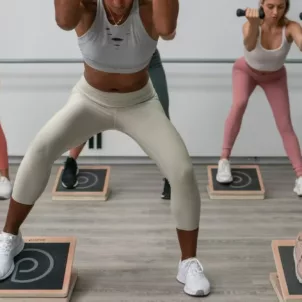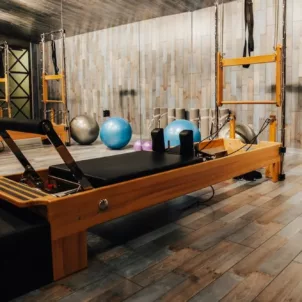Medically Reviewed By
Gaby Vaca-Flores, RDN, CLE
Registered Dietitian Nutritionist
Binge-watching season one of “Stranger Things.” Working on your computer. Battling the morning and evening commutes to and from the office. What do these things all have in common? You’re usually sitting down when you do them. Experts agree that if you’re sitting for long periods of time, you’re messing with your health—even if you work out consistently and enjoy a healthy diet. But don’t throw in the proverbial sweat towel just yet.
We chatted with David Weintraub, owner of Bodyworks DW in NYC, New York, and Jay Dicharry, PT and director of REP Lab in Bend, Oregon, who gave us the scoop on how to improve your office health habits and finally take a break.
The Negative Effects of Sitting
Before we hit the solutions, you need to know what you’re up against. The short term risks include upper and lower back pain, shoulder pain, neck pain, hip pain, knee pain, and wrist pain, says Weintraub. “All these come from locking into one position for too long which causes the body to slowly but surely change the fascia to tighten up muscles to ‘help’ you sit longer,” he explains. “The problem is that while this helps with being in a sitting posture, sitting posture is useless for most of the rest of our daily activities.” If you ignore these short term problems, they can develop into other problems like muscle tears, and tendonitis, and slipped discs. Weintraub says you even run the risk of bone fractures – not necessarily from sitting, but from exercising with poor form causes by lots of sitting. “Essentially, the muscles stiffen into a sitting posture which creates aches. If ignored, this stiffened postures negatively affects your form for all other activities, which if ignored leads to wear and tear injuries,” he says. In the long term, studies have found that the more you sit, the more you’re at risk for certain diseases like Type 2 diabetes. Luckily, there are things you can do to help.14 Beneficial Ways to Take a Break from Work
1. Walk Every 30 Minutes
The how: Every 30 minutes, get up and walk around for two minutes. (If you find yourself consistently sucked into an email vortex, Weintraub recommends using a timer or Post-It notes on your computer.) The why: “If you can break the cycle of what your body is doing you can help avoid the tendency for it to lock the muscles down in a sitting position,” he explains.2. Take the Load Off
The how: At lunchtime and at the end of the day, lie down on the floor and rest your legs on a chair for five minutes. Weintraub says your legs should be bent at the hips and knees, and you shouldn’t need to engage any muscles. (We’ll get to tips on how to deal with your co-worker’s side-eye in a moment.) The why: “This puts you into a sitting posture but takes away any load off the muscles… when you shorten a muscle but take away the load it gets to relax,” he says.3. Don’t Feel Guilty
The how: “I think the biggest impediment that folks have to changing is taking breaks,” says Weintraub. “There is a lot of inertia in the workplace around having to always ‘look like you are working’ – i.e. sitting at your desk.” If you’re worried that getting up from your desk will make it look like you’re goofing off, Weintraub says that studies show productivity rises when employees feel better and take breaks. “There are diminishing returns to focusing on anything after about 40 minutes. Usually a short break helps reset the brain and that answer to that problem that seemed so hard 10 minutes ago suddenly pops into your head,” he explains further. “Google some studies on taking breaks for better productivity and share them with your workmates (and your boss) and create a team vibe on stretching more.” (I’ll consider this post my official note to the HUM team.) The why: “The underlying context that people have that they either have to choose to take care of themselves or do a better job at work, is a false one. You get to have both.” At the very least, get up and get some more water or go to the bathroom. (The latter is a big one: Weintraub says if you are trying to hold it in while you get through that report, your muscles become even tighter and it makes things worse.)4. Stretch Your Hips
The how: Kneel down on one knee. Keeping your bottom thigh vertical, tuck your tailbone. You should feel a deep stretch in front of the hip joint, says Dicharry. The why: “The reality is that we can’t undo 50 hours a week of sitting with 50 hours of corrective exercise, but we should try to get moving more throughout the day.”5. Open Up Your Mid-Back
The how: Lie down on top of a foam roller (place it under your mid-back). Support your hands with your head, lift your hips off the floor, and let the foam roller do the work, says Dicharry.
The why: “Sitting causes the mid back to be SO stiff, and this screws up your core stability and lumbar posture, and also causes ‘computer neck’,” he explains.
6. Stretch Your Neck
The how: “Sit nice and tall on your chair, and then place your right hand under your right hip palm side up. This will keep your shoulder blade low and flat along your ribs. Now gently tilt the head to the left until you feel a gradual stretch in the side of the neck. Do this three to four times a day for a minute each side,” says Dicharry. The why: It helps relieve the strain put on your neck.7. Move Your Arms
The how: Raise your arms above your head. The why: “Sounds crazy — but just raising your arms up above your head helps pull you back to proper sitting posture,” explains Dicharry.8. Exercise with Caution
The how: Don’t sit all day without any breaks, then hit up your CrossFit or SoulCycle class. The why: “Lets say you train 15 hrs a week. That’s great. But think about how much you DON’T train during the week. All the sitting at work, sitting in the car, carrying heavy backpacks, and texting forces us into horrible postures,” says Dicharry. “Your body really gets used to these positions! And then we suddenly put on our workout clothes and expect our body to transform into Superman… well… good luck with that!” “Our muscles and tendons get short and stick together, and the joints become stiff, and the postural muscles that should keep us aligned shut off and go have a drink,” he explains.9. Download an App
The how: “There are apps for your desktop that will lock your screen, make you unable to continue working, and prompt you to get up and move around,” says Weintraub. Try downloading Stand Up! The Work Break Timer or Workrave. The why: The more you move during the day, the better.10. Listen to Your Body
The how: Learn to check in with your body, says Weintraub. When you feel that it’s not happy, that needs to become a cue to get up and move. (Don’t worry, you’ll get there – Weintraub has been practicing this for so long that his brain sends red flags if he sits for more than 30-45 minutes). The first flag is typically that your butt hurts, then second your back, and the third your neck. Pay attention to what your body is telling you. The why: It’s simple: Sitting all day isn’t what your body was designed for.11. Alternate Between Sitting and Standing
The how: Get a standing desk for your office. I’ve seen great results and feedback from clients who have converted to them, so I’m a fan,” says Weintraub. Make sure that it’s convertible from sitting to standing, says Weintraub, because if you switch from sitting all day to standing all day you’re just trading one set of problems for another. “Ask any chef what standing all day does to their body,” he says. The why: “In general, holding any posture for long periods of time is a bad idea, whether it’s sitting or standing,” says Weintraub. “Sitting is a bit worse though as that posture has no practical applications beyond sitting. With standing, at least it’s somewhat related to other activities like walking.” Break up your day by switching off every hour. And just because you have a standing desk doesn’t mean you can forego those two minute walks – it’s important to keep moving.12. Fix the Quantity, Then the Quality
The how: Start by reducing the number of hours you sit per day by incorporating as many of the above tips as you can. Then train yourself to sit with the best posture. The why: “The worst day I’ve ever heard of is day trading, where I have clients glued to three to four monitors for 12-16 hours at a time, with maybe one break if they are lucky. “Quantity” of sitting (number of hours total, plus how long is each session within a day without a break) is the biggest thing to fix first,” says Weintraub. Once you stop sitting so much and incorporate the tips above, then start looking at the quality of your sitting.13. Sit Right
The how: Look at the quality of your sitting. “Are you sitting on your Sitz bones (the loops at the bottom of your pelvis) like you are designed to, or are you rolled back onto your tailbone which overstretches your low back? Most people do the latter,” Weintraub says. It’s best to sit with your hips slightly lower than your knees, he explains. “f you are tall, in all likelihood your office chair is too low for you to sit properly. If you are very short, it’s often too high to sit properly without using a footstool. I raise and lower my chair slightly throughout the day to change up which muscles are working. Also moving around on a rocking base helps me move even while sitting.” The why: If you aren’t sitting correctly, you can make aches and pains worse. Over time, they can become the medium risk problems we discussed at the beginning.14. Pick a Chair with a Rocking Base
The how: Exactly like it sounds. Sit on a chair that has a rocking base that has no back or arms. (This is what Weintraub uses.) The why: Simply put, you can’t lounge in it or you’ll fall over. “If you are not used to sitting with good posture, you’ll notice feeling uncomfortable way sooner when you do. That’s the signal to either get up and move around, change up the chair height, or rock on the base.”More like this









